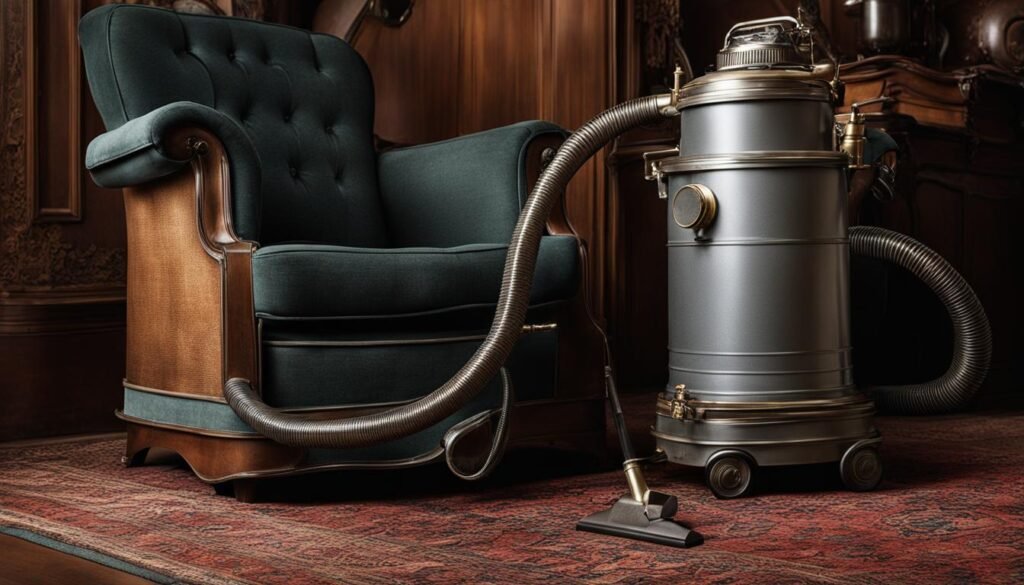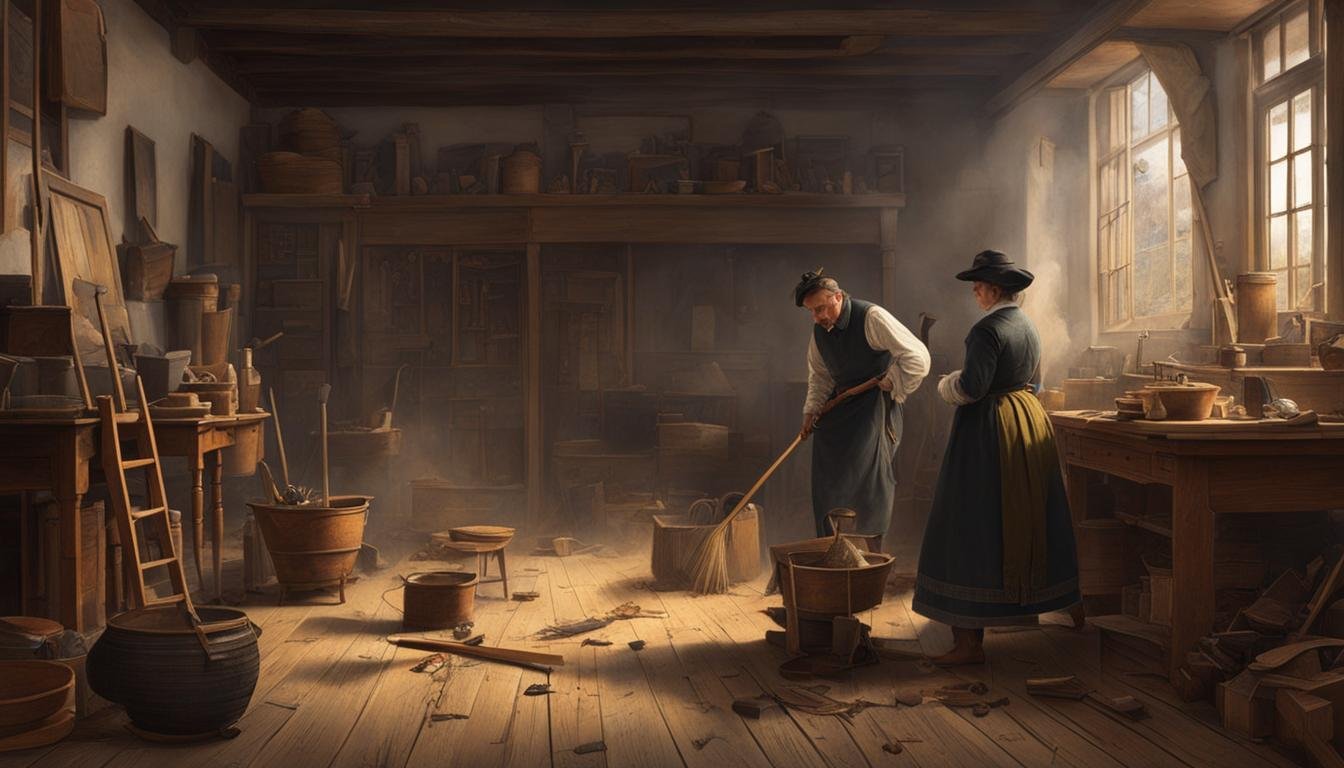The vacuum cleaner, a device that uses suction to remove dirt from surfaces, was invented in 1901 by engineer Hubert Cecil Booth of England. Booth was inspired by a demonstration of a carpet cleaning machine and realized the potential for a vacuum cleaner that could suck up dirt through a filter.
He created a large, horse-drawn machine called “Puffing Billy” that toured the streets of London, cleaning carpets for wealthy homeowners. Over time, the vacuum cleaner became smaller, more portable, and more affordable, eventually becoming a household staple.
Key Takeaways:
- The vacuum cleaner was invented in 1901 by engineer Hubert Cecil Booth of England.
- Booth was inspired by a demonstration of a carpet cleaning machine.
- He created a large, horse-drawn machine called “Puffing Billy” that toured the streets of London.
- The vacuum cleaner has evolved over time, becoming smaller, more portable, and more affordable.
- Today, the vacuum cleaner is a common and essential appliance found in households worldwide.
Evolution of the Vacuum Cleaner
Before the invention of the vacuum cleaner, early cleaning devices such as carpet sweepers were used to clean floors. However, it was the continuous efforts and innovations of inventors that led to the development of the first vacuum cleaners.
- Daniel Hess (1860): The first manual vacuum cleaner was invented by Daniel Hess in 1860. His design incorporated a rotating brush and bellows, which generated suction to remove dirt from surfaces.
- Ives W. McGaffey (1869): In 1869, Ives W. McGaffey invented the “Whirlwind,” a belt-driven fan-powered cleaning device. This invention marked an important step towards the mechanization of cleaning processes.
- Walter Griffiths (1905): Walter Griffiths developed the first portable vacuum cleaner in 1905. His invention utilized bellows to create suction and effectively suck up dust and debris.
- James B. Kirby (1906): James B. Kirby invented the “Domestic Cyclone” in 1906. This vacuum cleaner used water for dirt separation, setting the stage for future advancements in filtration technology.
- James Murray Spangler (1907): James Murray Spangler, a janitor, created the first portable electric vacuum cleaner in 1907. His invention featured an electric motor that provided powerful suction, improving the efficiency of the cleaning process. Spangler later sold his invention to William Henry Hoover.
- Hoover (1926): William Henry Hoover further refined the electric vacuum cleaner and introduced the first upright model in 1926. The Hoover brand became synonymous with vacuum cleaners and revolutionized the industry.
These early vacuum cleaners laid the foundation for the modern devices we use today. They were the pioneers of a technology that transformed cleaning practices and made household chores significantly easier.
| Inventor | Year | Vacuum Cleaner |
|---|---|---|
| Daniel Hess | 1860 | Manual vacuum cleaner with rotating brush and bellows |
| Ives W. McGaffey | 1869 | “Whirlwind” belt-driven fan-powered cleaning device |
| Walter Griffiths | 1905 | First portable vacuum cleaner using bellows |
| James B. Kirby | 1906 | “Domestic Cyclone” utilizing water for dirt separation |
| James Murray Spangler | 1907 | First portable electric vacuum cleaner |
| William Henry Hoover | 1926 | Introduction of the first upright vacuum cleaner |
Vacuum Cleaners Become Popular
After the Second World War, vacuum cleaners became more affordable and common among the middle classes. They quickly gained popularity and were sought after by notable figures such as Tzar Nicholas II and Kaiser Wilhelm II. These influential individuals recognized the convenience and efficiency of the vacuum cleaner in maintaining their lavish residences.
Not only were vacuum cleaners embraced by the aristocracy, but they also found their way into prestigious establishments like Buckingham Palace and the House of Commons. These institutions relied on vacuum cleaners to ensure cleanliness and presentable appearances on a daily basis.
The association between vacuum cleaners and the brand name “Hoover” played a significant role in their popularity. The American company employed successful advertising strategies that firmly established the name Hoover as synonymous with vacuum cleaners. This strong branding helped solidify the position of vacuum cleaners as essential household appliances.
Over time, vacuum cleaners continued to evolve, with improvements in technology leading to the introduction of smaller and more portable models. This made it easier for households to keep their living spaces clean with greater convenience.

Today, vacuum cleaners come in various types to cater to different needs. From handheld variants for quick cleanups to powerful industrial models for commercial use, there is a vacuum cleaner suitable for every situation. Even the introduction of robotic vacuum cleaners has revolutionized the cleaning experience, offering hands-free operation and automated cleaning routines.
Conclusion
The history of the vacuum cleaner is a testament to the remarkable ingenuity of inventors throughout the years. The invention of the vacuum cleaner revolutionized cleaning practices, making household cleaning more efficient and convenient. From the early manual models to the modern, technologically advanced versions we have today, vacuum cleaners have evolved significantly.
Throughout history, various inventors and engineers have contributed to the development of the vacuum cleaner. Starting with Hubert Cecil Booth’s invention of the first powered vacuum cleaner in 1901, to James Murray Spangler’s portable electric vacuum cleaner in 1907, and the introduction of the first upright model by William Henry Hoover in 1926.
Today, vacuum cleaners are a common and essential appliance in households worldwide. They have become more compact, lightweight, and even equipped with smart features and robotic capabilities. The invention of the vacuum cleaner has had a lasting impact on the way we clean our homes and maintain hygiene, saving us time and effort.
FAQ
Where was the vacuum cleaner invented?
The vacuum cleaner was invented in England by engineer Hubert Cecil Booth in 1901.
What is the history of the vacuum cleaner?
The history of the vacuum cleaner dates back to the 19th century. The first manual vacuum cleaner was invented by Daniel Hess in 1860, followed by Ives W. McGaffey’s “Whirlwind” in 1869. Walter Griffiths developed the first portable vacuum cleaner in 1905, and James B. Kirby introduced the “Domestic Cyclone” in 1906. James Murray Spangler created the first portable electric vacuum cleaner in 1907, later sold to William Henry Hoover, who introduced the first upright model in 1926.
How did vacuum cleaners become popular?
Vacuum cleaners gained popularity after World War II, becoming affordable for the middle classes. The association between vacuum cleaners and the brand name “Hoover” developed due to the advertising strategies of the American company. Vacuum cleaners were used by notable figures and establishments, further boosting their popularity.
What is the importance of the vacuum cleaner’s invention?
The invention of the vacuum cleaner revolutionized cleaning practices, making household cleaning more efficient. It has had a significant impact on the way we clean our homes and maintain hygiene.





Leave a Reply